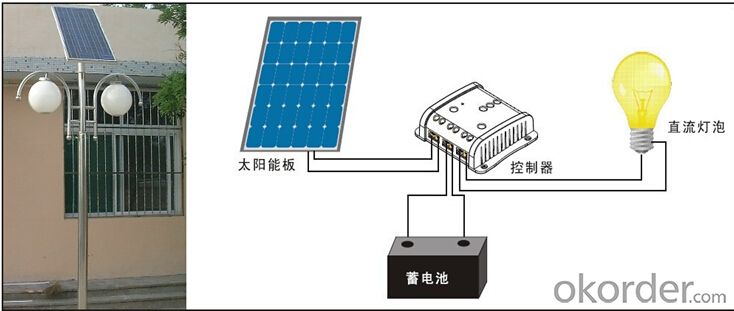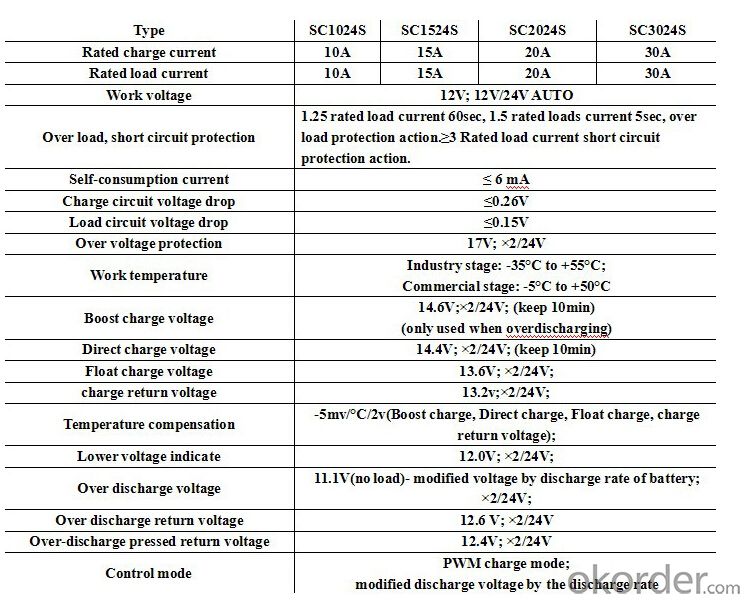BYGD Solar Charger Controller Model SC2024S for Streetlight system
- Loading Port:
- Shanghai
- Payment Terms:
- TT OR LC
- Min Order Qty:
- 10 unit
- Supply Capability:
- 50 unit/month
OKorder Service Pledge
OKorder Financial Service
You Might Also Like
Details of products:
product model: SC2024S 20A
External Size:133mm×70mm
Mounting hole Size:126mm×50mm
Performance
12V/24V automatical adaption, control and set button changed into tact key, larger contact terminal can offer wire of 6 m2
◆ double LED digital display, clear for observation
◆ recharging mode by three phases
◆ PWM pulse modulated recharging technology
◆set light-dependent control and 1-13hous time control
◆short circuit protection, overvoltage protection, overcurrent protection and lighting protection
◆standy current no more than 5mA
example

Technical characteristics

P.S.: This product is manufactured by order, so please call us for more info and service
- Q:Solar controller is called solar charge and discharge controller, is used in solar power system, the control of multi-channel solar cell array on the battery charging and battery to the solar inverter load power supply automatic control equipment
- Solar controller is the power (including battery and electricity), solar panels, the load of the center connector, why say so? Because the above components must be connected with the solar controller in order to be able to achieve the work, in general, the controller's main function is to control the solar panels on the battery charge or disconnect, control the load power supply or disconnect, control the city Electricity and battery switching between the main is that these features, and other, such as light control to open, light control off, timing delay off, manual switch, and debugging and other functions.
- Q:What is the maximum load power of a solar controller?
- The maximum load power of a solar controller refers to the maximum amount of power that the controller can handle and deliver to connected loads. The load power capacity of a solar controller is typically specified by the manufacturer and depends on the specific model and design of the controller. It is important to consider the maximum load power capacity of a solar controller when designing and configuring a solar power system. Exceeding the maximum load power capacity can result in overheating, damage to the controller, and potential failure of the connected loads. When selecting a solar controller, it is essential to ensure that the maximum load power capacity meets or exceeds the power requirements of the connected loads. If the load power requirements exceed the capacity of a single solar controller, it may be necessary to use multiple controllers or upgrade to a higher-capacity controller to ensure optimal performance and reliability of the system.
- Q:How does a solar controller handle the protection against battery reverse polarity?
- A solar controller handles the protection against battery reverse polarity by incorporating a built-in diode or a solid-state switch. This device ensures that the current flows in the correct direction, preventing any damage to the battery caused by reverse polarity.
- Q:What is the maximum number of charging stages supported by a solar controller?
- The maximum number of charging stages supported by a solar controller can vary depending on the specific model and manufacturer. However, many solar controllers typically support up to three charging stages: bulk charging, absorption charging, and float charging.
- Q:Which type of solar controller is more efficient?
- MPPT (Maximum Power Point Tracking) solar controllers are generally considered to be more efficient compared to PWM (Pulse Width Modulation) solar controllers. MPPT controllers are able to maximize the power output from solar panels by continuously tracking the maximum power point of the panels, resulting in higher efficiency and increased energy harvest. On the other hand, PWM controllers regulate the voltage output from the solar panels by rapidly turning the current flow on and off, which can lead to some power loss. Therefore, MPPT controllers are the preferred choice for maximizing solar energy conversion and overall efficiency.
- Q:Can a solar controller be used with a solar-powered agricultural farm?
- Yes, a solar controller can be used with a solar-powered agricultural farm. A solar controller helps regulate and optimize the charging and discharging of batteries in a solar power system. By using a solar controller, the farm can effectively manage and control the energy generated by the solar panels, ensuring efficient and reliable power supply for various agricultural operations.
- Q:How do I integrate a solar controller with my existing solar system?
- To integrate a solar controller with your existing solar system, you need to follow a few steps. First, ensure that the solar controller you have is compatible with your solar panels and system specifications. Then, locate the main junction box or connection point of your solar system. Connect the solar controller to this junction box using appropriate wiring and connectors. Make sure to follow the manufacturer's instructions for proper wiring and connections. Finally, configure the settings on the solar controller according to your system requirements and preferences. It is recommended to consult a professional or refer to the user manual for specific guidance tailored to your solar controller model.
- Q:How do you prevent voltage spikes with a solar controller?
- One way to prevent voltage spikes with a solar controller is by using a voltage regulator or a charge controller. These devices are designed to regulate the voltage and prevent it from exceeding a certain threshold, thus avoiding any potential damage to the system. Additionally, proper grounding and wiring techniques, along with the use of surge protection devices, can also help in preventing voltage spikes and ensuring the safe operation of the solar controller.
- Q:Can a solar controller be used with solar-powered remote control systems?
- Yes, a solar controller can be used with solar-powered remote control systems. A solar controller regulates and optimizes the charging process of batteries in solar systems, ensuring the efficient use of solar power. It can be integrated into solar-powered remote control systems to manage the energy flow and maintain battery health, enabling reliable and sustainable operation.
- Q:Can a solar controller be used in a standalone solar power system?
- Yes, a solar controller can be used in a standalone solar power system. In fact, it is an essential component of such a system. A solar controller, also known as a charge controller or solar regulator, is responsible for regulating the flow of electricity from the solar panels to the battery bank in a solar power system. Its main function is to prevent overcharging of the batteries, which can damage them and reduce their lifespan. In a standalone solar power system, where there is no grid connection or backup generator, the solar controller plays a crucial role in ensuring the efficient and safe operation of the system. It monitors the voltage and current coming from the solar panels and adjusts the charging rate accordingly to prevent overcharging. It also protects the batteries from over-discharging, which can also be damaging. Additionally, some solar controllers also provide other useful features such as load control, which allows you to connect and power DC loads directly from the battery bank. This can be helpful in powering appliances or devices even when the solar panels are not generating electricity. Overall, a solar controller is an essential component in a standalone solar power system as it helps optimize the charging and discharging of the batteries, prolonging their lifespan and ensuring reliable power supply.
1. Manufacturer Overview |
|
|---|---|
| Location | |
| Year Established | |
| Annual Output Value | |
| Main Markets | |
| Company Certifications | |
2. Manufacturer Certificates |
|
|---|---|
| a) Certification Name | |
| Range | |
| Reference | |
| Validity Period | |
3. Manufacturer Capability |
|
|---|---|
| a)Trade Capacity | |
| Nearest Port | |
| Export Percentage | |
| No.of Employees in Trade Department | |
| Language Spoken: | |
| b)Factory Information | |
| Factory Size: | |
| No. of Production Lines | |
| Contract Manufacturing | |
| Product Price Range | |
Send your message to us
BYGD Solar Charger Controller Model SC2024S for Streetlight system
- Loading Port:
- Shanghai
- Payment Terms:
- TT OR LC
- Min Order Qty:
- 10 unit
- Supply Capability:
- 50 unit/month
OKorder Service Pledge
OKorder Financial Service
Similar products
New products
Hot products
Related keywords




























